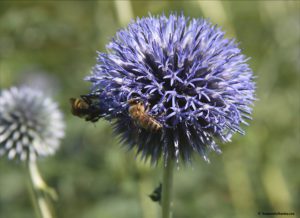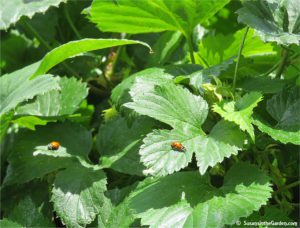Attracting beneficial insects
When I talk about attracting insects to the garden, this is a common reaction: “Why would I do that?! I don’t want more insects in my garden!” Attracting beneficial insects, as well as pollinators, is exactly what we need to do. That way, we’ll keep damaging insects in check and create a balanced ecosystem within our gardens.
When I think of beneficial insects and pollinators, here’s what comes to mind. Beetles, ladybugs, parasitic wasps, lacewings, praying mantises, spiders and solitary bees like mason bees.
You were probably doing OK with the list until I mentioned spiders, right? We humans seem to have an innate fear of arachnids. I agree they are kind of creepy critters. But spiders have big appetites for all types of problem insects in our gardens. So for that very reason, I’m more than happy to put out the welcome mat for them.
So how to we draw in the beneficials and pollinators?
The most important thing all of us need to do is to lose the pesticides! Sure, chemicals are a quick and easy product to use. But they indiscriminately kill off both the problem insects and beneficials alike. As a result, our garden ecosystems are out of balance.
For example, if you kill off the ladybugs, who’s going to eat all of those pesky aphids? If you kill off the bees, who will pollinate your squash plants and apple blossoms?
When folks hear that I garden organically, they want to know what I do about them. I’m often asked, “Then what do you do with all of the bugs that are eating your garden?”
Take steps to help out the insect world:
The simple answer is that I have very little insect problems. That’s because I’ve helped establish a balance of beneficial and damaging insects by completely avoiding pesticides.
So that’s step #1. No more chemicals, folks! It will save you money and keep you away from the health hazards of using them. Most importantly, you’ll help the environment.
Step #2 is to attract birds. A large percentage of them are insectivores. They do a great job of keeping problem insects at a manageable level. Perhaps you’re interested in attracting birds for this reason. Plus you want to watch and enjoy them in your own garden. Please read my article on attracting birds. It’s part of my “Birds in the Garden” guide. It includes profiles of the birds I see in my garden and identifies which ones are insectivores.
Step #3, in my humble opinion, is the most fun one: build an insect hotel.
In early 2015, my husband, Bill, and I built one in our garden. We’d seen them in some botanical gardens in both the U.S. and abroad. Here’s the concept behind them:
They provide shelter and nesting materials for insects to hibernate and/or raise a brood. An insect hotel can be any size, style or shape you want. It just needs to be sheltered from the weather with a roof. You also want to orient it facing south for maximum light and warmth.
Natural materials you can use to fill an insect hotel:
- Logs or wood blocks with 1/4″ to 5/16″ holes drilled into them
- Dry leaves and branches
- Masonry bricks containing holes
- Mason bee tubes
- Bamboo
- Clay pots
- Driftwood
- Pine cones
- Roofing tiles
- Rolled-up paper or cardboard
- Wood scraps
- Reeds or straw
- Loose tree bark
Here is a video, showing how we put our insect hotel together. Remember that you can build yours any old way, but this will give you some ideas:
We had so much fun putting it together and then watching the insect activity in and around it! Here’s a video showing mason bees coming and going:
I do hope you’ll consider building your own insect hotel. It’s a wonderful project to involve kids in, so they will gain a better understanding of the natural world. Hopefully they and won’t look upon insects as something to squish! Insects are vital to the health of our gardens and the world around us.


